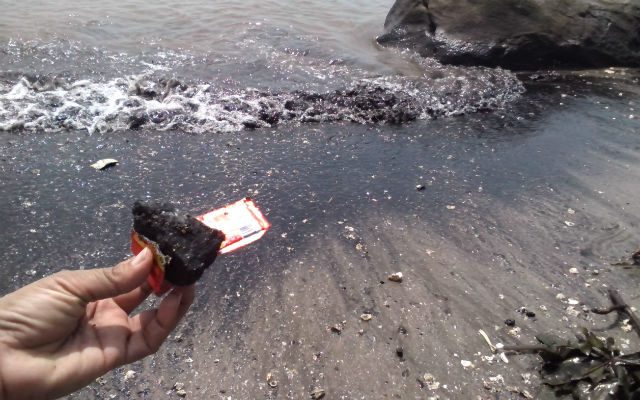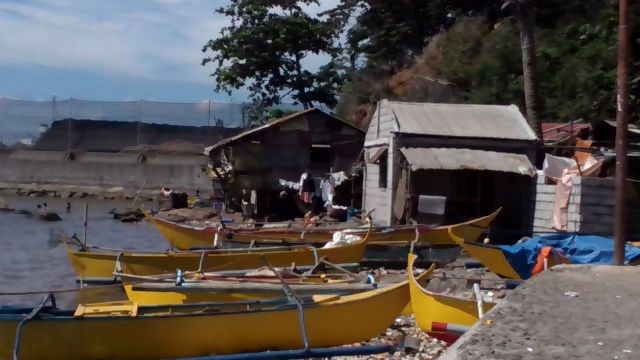SUMMARY
This is AI generated summarization, which may have errors. For context, always refer to the full article.

MANILA, Philippines – The wind blew, carrying with it a certain smell of sulfur and an amount of ash that later covered the road. It was like New Year’s Eve, except there were no fireworks and certainly nothing to celebrate.
This is everyday life for the community living near the coal-fired power plant in Lamao, Limay, Bataan, a barangay (community) of 18,000 people in the northern part of the Philippines.
Petron Corporation constructed the coal-fired powerplant in Lamao and has been in operation for 2 years. San Miguel Corporation (SMC), through SMC Global Power Holdings Corp., has been constructing its other coal-fired power plants in the area which are set to be online by 2016 and 2017.
More expansions by the company are eyed as Ramon Ang, president of SMC, has been openly aggressive in building coal-fired power plants in the area and other parts of the country.
According to Earthjustice, coal ash remains from burning coal in power plants are toxic and can cause cancer, respiratory illness, neurological damage, and developmental problems. The toxic level of coal ash which mostly come from arsenic, mercury, lead, and chromium, also poison drinking water sources. In fact, a percentage of the population has acquired respiratory problems and water has recently been contaminated.
Approximately 8 kilometers away from Lamao, Barangay Lucanin in Mariveles, Bataan also face the same hazards: the sea, their source of livelihood, has been contaminated with coal ash, and residents have acquired skin diseases. According to Derek Cabe of Nuclear Free Bataan Movement, coal ash waste can reach up to 40 kilometer radius.
But coal ash in the area isn’t only brought to them by the wind, Petron Corporation also dumps their coal ash waste in the area, which the company later turns into cement. Lucanin has seen the effects of this waste as the community experiences high morbidity of upper respiratory diseases.
Injustices
But ash fall is just the tip of the iceberg. Residents of Lamao are facing violence and harassment amidst the fight against their eviction from their own land to accommodate the new coal-fired power plants by SMC. The community has been up in arms, especially with 110 families facing eviction — but not without cost.
John*, an officer of Federation of Lamao Concerned Citizens, Inc. (FLACCI), recalls that on February 21, 2014, members of the Merit Security Agency came to the site of his small buying and selling of scrap materials business, armed with long rifles, and started destroying his storage space. Even prior to this, Ana*, another resident of Lamao, was harassed by security guards of the Philippine National Oil Company (PNOC), also from the same security agency.
Residents of Lamao are no longer permitted to renovate, improve, or repair their homes. According to PNOC, they will be demolished in preparation for the multiple coal-fired power plants which will be built by SMC.
James* says that Merit Security Agency has put up check points in the area, inspecting each passerby for any construction materials. In addition to checkpoints, 5 guards are on roving duty daily, checking if any of the residents have been doing home improvements. The guards have already destroyed numerous houses in the area.
There are more than 40 coal-fired power plants which have been approved to be built in different parts of the country. These are said to be the answer to the country’s energy crisis, despite opposition from the public and environmental groups.
Campaigns from different organizations highlight renewable energy as the path to a sustainable and a more environment and health friendly future. But is there room for a shift from dirty energy to renewable energy in a country whose president does not support it?

In the State of the Nation Address (SONA) of President Aquino last 2013, he said, “Did they happen to mention that renewable energy is also more expensive — from the cost of building the plants to the eventual price of energy? Did they mention that it cannot provide the baseload — the capacity required to make sure brownouts do not occur? If you put up a wind-powered plant, what do you do when there is no wind? If you put up a solar plant, what do you when the sky is cloudy?”
Land disputes
Jana* started rebuilding her small rental space in Lamao. It cost her P3,000 which she gave to a certain Mr Ignacio, commander of the security agency, and a certain Mr Miranda, to allow her to safely build her space. But in February 2014, she was met with harassment when Mr Ignacio was replaced by a certain Mr Carag who ordered her place to be demolished. With her husband out of the country and for fear of retaliation, Jana has filed no cases against anyone.
Land dispute between PNOC and the residents of Lamao has been ongoing for some time. According to the residents, the area of Lamao has been awarded to them by President Ramon Magsaysay in the 50s. However, during the presidency of Ferdinand Marcos, who created the PNOC to respond to the oil crisis, Lamao was awarded to the PNOC and has since then claimed the area.

As the expansion plans of coal-fired power plants in the area increases, the number of human rights violations also seem to grow in number. While residents have complained about health and water hazards the coal-fired power plant has caused, PNOC uses the same rhetoric to drive them out of their land.
Instead of shutting down the coal power plant which has affected the community, PNOC has told them to leave their homes for a relocation site which will be provided for them. But as with all relocation sites in the Philippines, it is far from their livelihood and without access to employment.
The belief that coal is cheap has been accepted but sadly, its real costs — health hazards, damage to agriculture and fisheries, water contamination, environmental damage, and land grabbing, all of which are human rights violations — are not calculated.
The community in Lamao has been asking the government to clean-up the environmental hazards and toxic wastes from the Petron coal-fired power plant. They also ask the government to allow them to stay in the land that has been awarded to them and their families in the 50s, which will be taken away from them to give way to more infrastructures that will increase endangerment of their lives and livelihood.
The residents are going against big corporations. What can the government do?
“RSA (Ramon Ang) is very bold. He builds plants even without offtake and financial closing. We should have more of his kind,” says Jericho Petilla, secretary of the Department of Energy (DOE).
The wind blows again and more coal ash cover the streets of Lamao, Limay, Bataan. – Rappler.com
*Names were changed for the safety of the people involved. This article was written with the help of Task Force Detainees of the Philippines (TFDP), Kilusan Bataan, Federation of Lamao Concerned Citizens, Inc. (FLACCI), and Nuclear Free Bataan Movement (NFBM). Photos from Kilusan Bataan and NFBM.
Renee Juliene Karunungan, 25, is the Advocacy Director of Dakila, an organization of artists creatively working towards social transformation. Dakila has been campaigning for human rights and climate justice since 2009. Renee is also a climate tracker for Adopt A Negotiator.
Add a comment
How does this make you feel?
There are no comments yet. Add your comment to start the conversation.